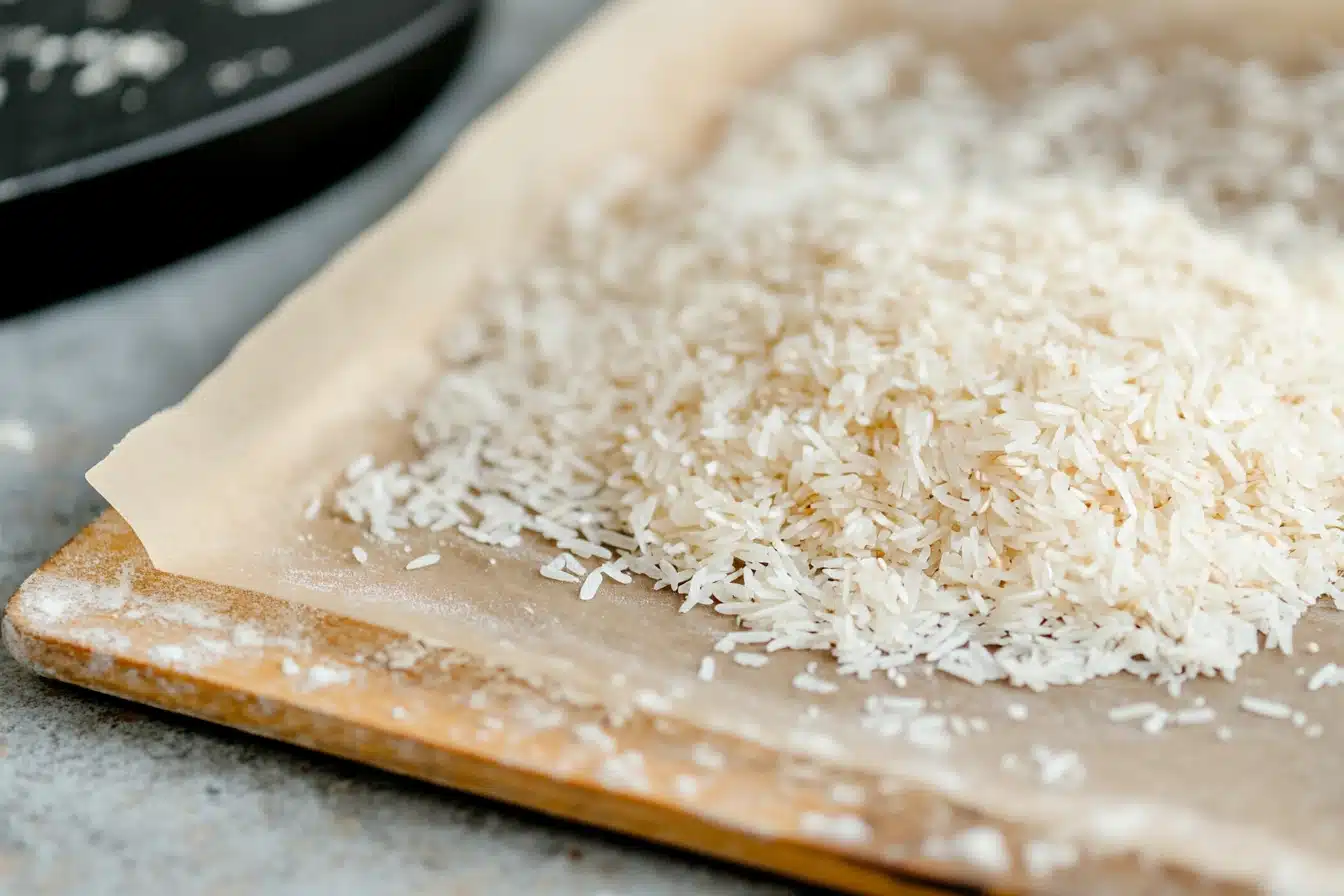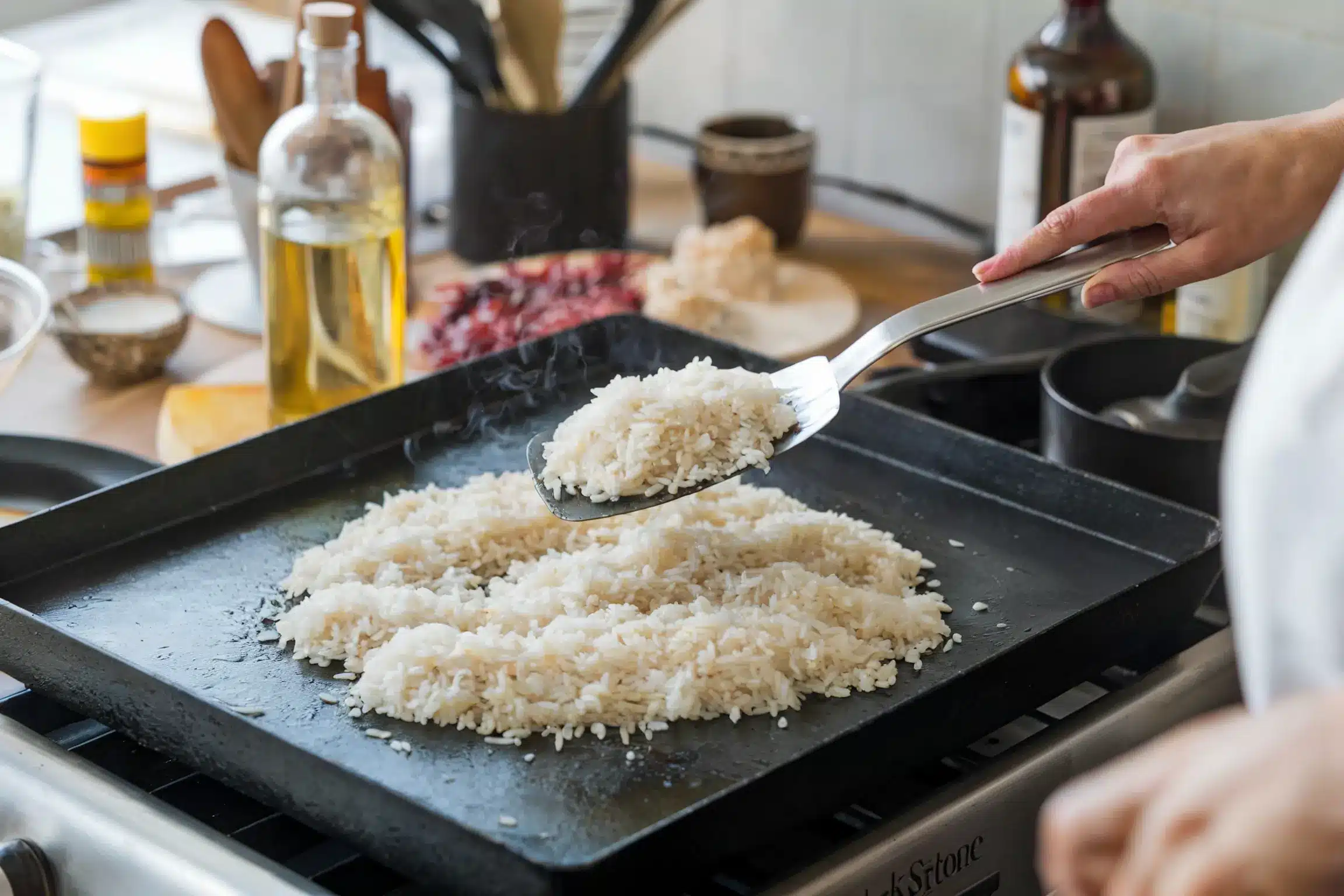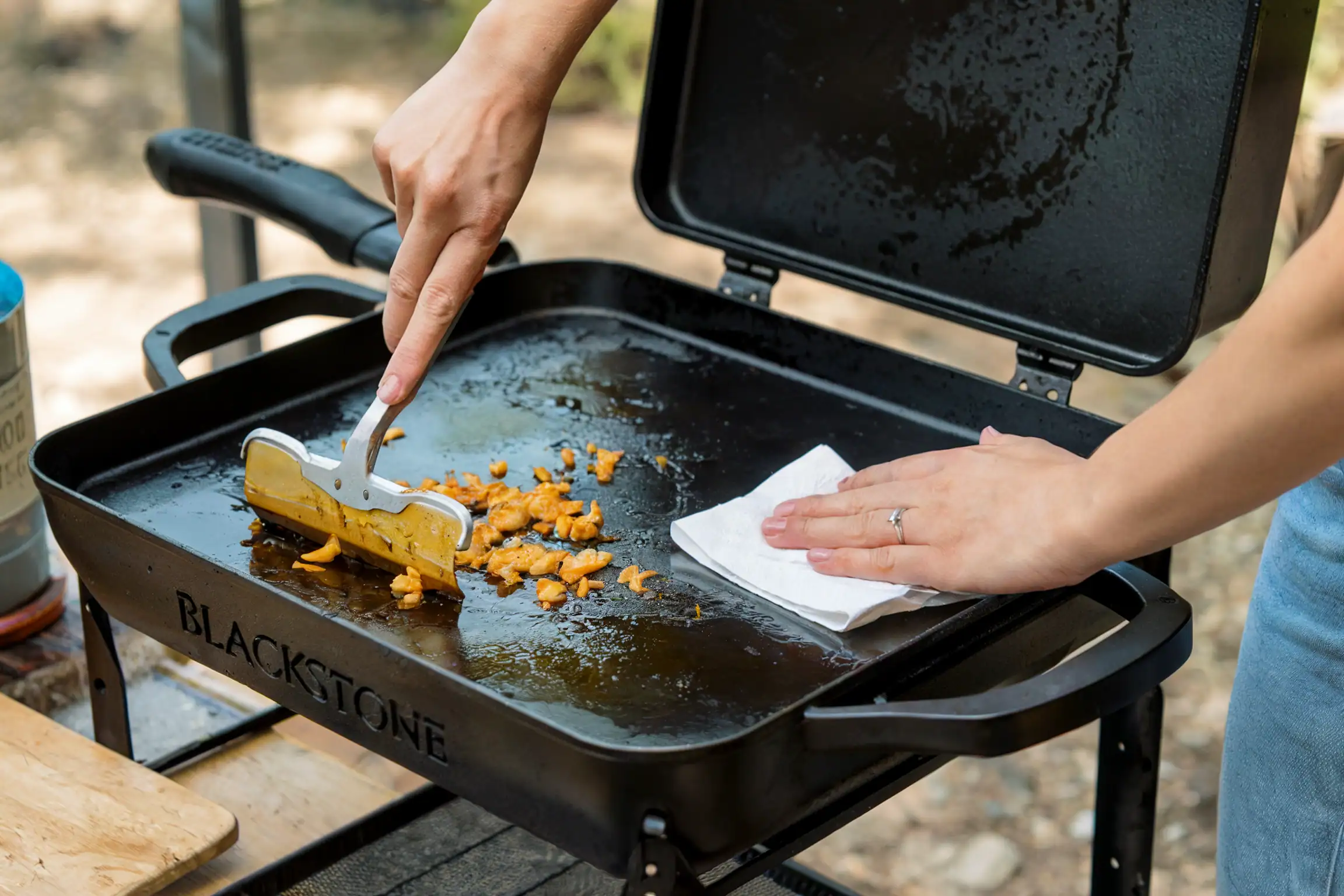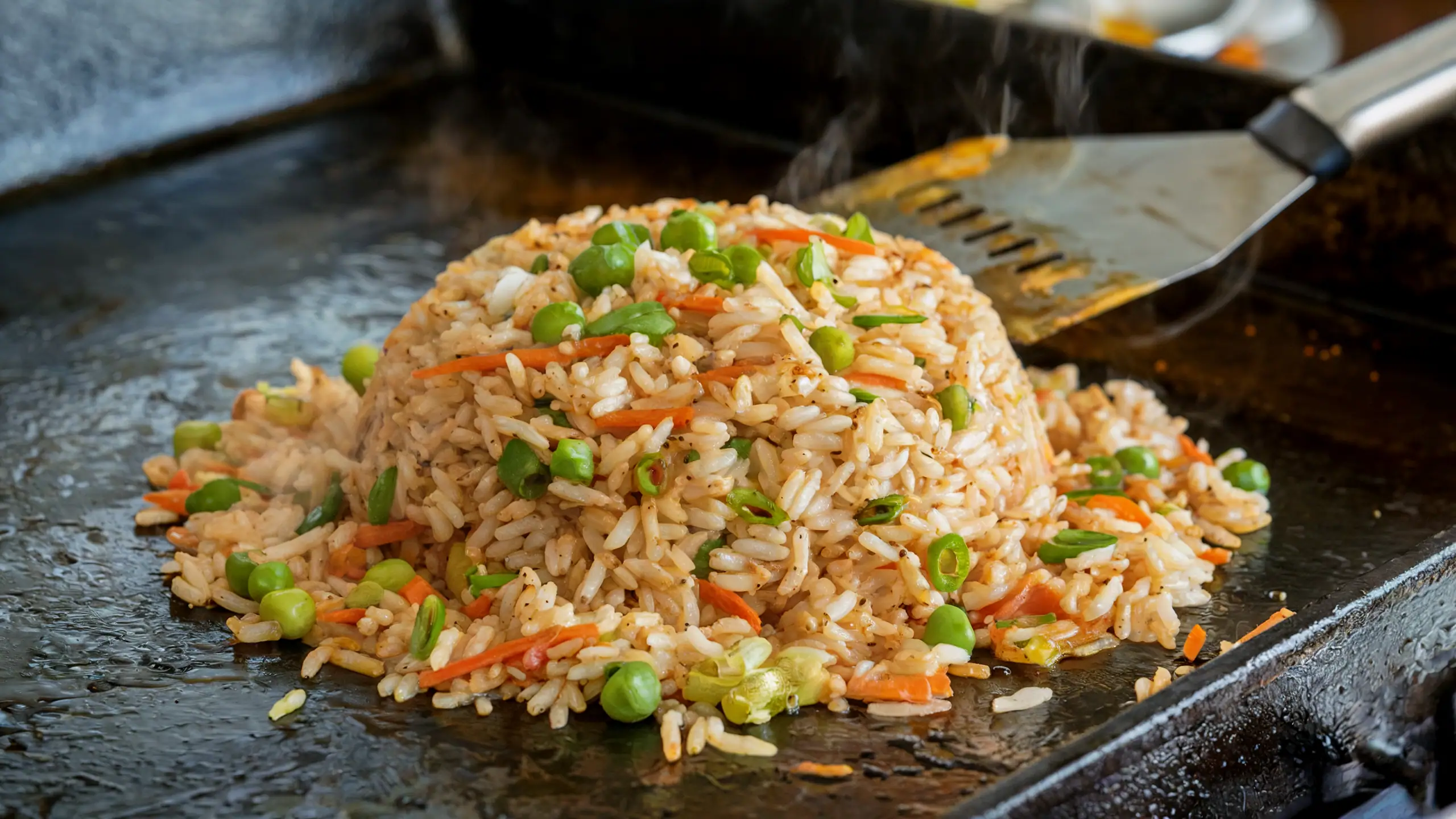How do you keep rice from sticking to Blackstone? If you’ve ever struggled with rice clumping or burning on your griddle, you’re not alone! Cooking rice on a Blackstone can be a game-changer, but without the right techniques, it can turn into a sticky mess.
The key to perfect, non-sticky rice lies in proper preparation, smart cooking techniques, and regular griddle maintenance. In this guide, you’ll learn exactly how to prevent rice from sticking, from choosing the best type of rice to cleaning your griddle the right way.
In This Article
Let’s dive in and make your Blackstone-cooked rice flawless every time! 🔥
Why Rice Sticks to a Blackstone Griddle
Rice sticking to a Blackstone griddle is a frustrating issue, but understanding why it happens is the first step to fixing it. Let’s break down the science behind sticky rice and the most common mistakes that lead to it.
The Science Behind Sticky Rice on a Griddle
Rice contains starch, and when heat is applied directly without the right precautions, that starch releases, causing the grains to stick together—and to the griddle. Unlike a non-stick pan, a Blackstone griddle requires proper seasoning and oiling to create a slick surface that prevents food from clinging.
Additionally, the moisture content in rice plays a significant role. Freshly cooked rice retains a lot of moisture, which, when combined with heat and starch, leads to clumping and sticking.
Common Mistakes That Cause Rice to Stick
If your rice constantly sticks to the griddle, you might be making one (or more) of these common mistakes:
- Using freshly cooked rice – Hot, steamy rice releases starch and moisture, making it more prone to sticking.
- Not preheating the Blackstone griddle properly – Cooking on a cold or unevenly heated surface increases the chances of sticking.
- Skipping the oil or using the wrong type – A dry griddle will make rice cling, while using the wrong oil can burn and create residue.
- Overcrowding the griddle – Too much rice in one spot prevents even cooking and increases sticking.
- Not seasoning your griddle – A poorly seasoned Blackstone griddle loses its non-stick properties over time.
The Role of Seasoning and Oil in Preventing Sticking
A well-seasoned griddle is key to preventing rice from sticking. Seasoning involves applying a thin layer of oil and heating it until it polymerizes, creating a natural non-stick coating.
Here’s how seasoning helps:
✅ Creates a smooth, slick surface that repels food
✅ Prevents moisture from seeping into the griddle’s pores
✅ Protects the griddle from rust and buildup
Using the right oil is just as important. Best oils for griddle cooking:
- Avocado oil (high smoke point)
- Vegetable oil
- Peanut oil
- Sunflower oil
Avoid butter alone—it has a low smoke point and can burn, causing residue to build up
Prepping Rice for a Blackstone Griddle

Cooking rice on a Blackstone griddle isn’t just about technique—it starts with proper preparation. The type of rice you use, how you cook it, and how you store it all play a huge role in keeping it from sticking. Let’s break it down step by step.
Choosing the Right Type of Rice: Long-Grain vs. Short-Grain
Not all rice is created equal, especially when cooking on a griddle. Long-grain rice like jasmine or basmati is the best choice because it has less surface starch, making it naturally less sticky. On the other hand, short-grain rice (like sushi rice) is packed with starch and tends to clump together—not ideal for a Blackstone griddle.
Best rice options for Blackstone cooking:
✅ Jasmine rice (light, fluffy, and fragrant)
✅ Basmati rice (firm texture, less sticky)
✅ Parboiled rice (pre-cooked and resistant to clumping)
If you must use short-grain rice, be sure to rinse it thoroughly to remove excess starch.
Properly Cooking and Cooling Rice Before Using on Blackstone
One of the biggest mistakes people make when cooking fried rice is using freshly cooked rice. Warm rice is loaded with moisture, which makes it clump and stick when it hits the griddle.
Here’s the best way to prepare rice for Blackstone cooking:
- Rinse the rice – Wash it under cold water until the water runs clear. This removes excess starch that causes stickiness.
- Cook it with slightly less water – A firmer texture is better for the griddle. A 1:1.75 rice-to-water ratio works well.
- Cool it properly – Spread the rice on a baking sheet and let it cool to room temperature.
Why Letting Rice Dry Out Overnight Reduces Stickiness
For the best results, refrigerate your rice uncovered for at least 4 hours—overnight is even better. Cold rice dries out, reducing moisture that can cause sticking. This method is a game-changer for making fried rice on a Blackstone griddle!
🔗 Related Read: Do You Cook the Rice Before Putting It on the Blackstone?
Now that your rice is prepped and ready, let’s move on to the best cooking techniques for a stick-free Blackstone experience!
Best Cooking Techniques to Prevent Sticking

Even with perfectly prepped rice, how you cook it makes all the difference. From heat control to the right amount of oil, these tips will help you master Blackstone griddle rice cooking without a sticky mess.
How to Preheat Your Blackstone Griddle Correctly
Preheating your Blackstone properly is crucial for preventing rice from sticking. A cold or unevenly heated griddle won’t create the non-stick surface needed for crispy, separate rice grains.
Follow these steps for perfect preheating:
✅ Turn the griddle to medium-high heat and let it warm up for at least 5–10 minutes.
✅ Test the heat by flicking a few drops of water—if they sizzle and dance, it’s ready.
✅ Adjust the temperature zones: use high heat for searing and lower heat for finishing.
Using the Right Amount of Oil and When to Add It
Oil is your best friend when cooking rice on a Blackstone. But too little oil causes sticking, and too much can make the rice greasy.
Here’s how to get it just right:
- Add 1–2 tablespoons of a high-smoke-point oil (like avocado or vegetable oil) once the griddle is hot.
- Use a spatula to spread the oil evenly across the surface.
- Immediately add your cold rice and start stirring to coat every grain.
🔥 Pro Tip: Don’t use olive oil! It has a low smoke point and can burn, leaving behind a sticky residue.
Spreading Rice Properly on the Griddle for Even Cooking
Dumping all your rice into one pile is a big mistake—it traps moisture and causes uneven cooking. Instead:
✅ Spread the rice in a thin, even layer to maximize surface contact.
✅ Let it sit for a few seconds to crisp up before stirring.
✅ Use a wide spatula to toss and flip the rice frequently.
By following these techniques, you’ll achieve that crispy, golden-brown texture without any of the frustrating stickiness.
🔗 More Fried Rice Tips: Fried Rice on Blackstone
Cleaning and Maintaining Your Blackstone to Avoid Sticky Residue

Even if you follow all the right cooking techniques, a poorly maintained Blackstone griddle can still cause rice to stick. Keeping your griddle in top condition ensures smooth, non-stick cooking every time.
How Seasoning Your Blackstone Prevents Sticking
A well-seasoned Blackstone griddle creates a natural, non-stick surface that makes cooking rice (and everything else) easier. But over time, improper cleaning or neglecting seasoning can lead to sticky spots.
Here’s how to maintain a perfectly seasoned griddle:
- Clean after each use – Wipe away food debris and oil residue while the griddle is still warm.
- Apply a thin layer of oil – After cleaning, spread a small amount of high-smoke-point oil (like avocado or flaxseed oil) across the surface.
- Heat the griddle – Turn the heat to high and let the oil smoke off. This bonds the oil to the metal, creating a protective, non-stick layer.
If you notice your Blackstone becoming sticky or rusted, re-seasoning might be necessary. Simply strip off old layers, heat the griddle, and apply multiple thin coats of oil until it’s slick and blackened.
Best Cleaning Methods After Cooking Rice
Cleaning your griddle the right way is essential for avoiding sticky residue buildup. Here’s the best approach:
✅ While the griddle is warm, scrape off food bits using a griddle scraper.
✅ Pour a little water onto tough spots—never use soap, as it can ruin seasoning.
✅ Wipe down with a paper towel or cloth until completely clean.
✅ Apply a light coat of oil to protect the surface before storing.
💡 Pro Tip: If rice sticks despite all precautions, use a pumice stone or grill brick to scrub off the residue without damaging the griddle.
Avoiding Residue Build-Up for Future Cooking
To keep your Blackstone non-stick for years, avoid these common mistakes:
🚫 Overusing butter – It burns quickly and leaves behind a sticky mess.
🚫 Cooking on a cold griddle – Always preheat properly before adding rice.
🚫 Using too much oil – A small amount is good, but excess can create buildup over time.
By sticking to these maintenance habits, your Blackstone will stay slick and ready for non-stick cooking every time.
🔗 Related Read: Fried Rice on Blackstone
Expert Tips for Perfect Fried Rice on a Blackstone
Now that you know how to keep rice from sticking, let’s take it up a notch! These pro tips will help you make restaurant-quality fried rice on your Blackstone griddle.
Using a Spatula to Keep Rice Moving and Prevent Sticking
One of the best ways to stop rice from sticking is to keep it moving. Unlike a regular frying pan, a griddle gives you a large surface area, so take advantage of it!
✅ Use a wide metal spatula to quickly toss and flip the rice.
✅ Stir frequently—don’t let rice sit in one spot too long.
✅ Chop up any clumps and mix evenly with other ingredients.
🔥 Bonus Tip: Want that classic fried rice texture? Press the rice down for a few seconds to get crispy, then toss it to prevent burning.
Adjusting Heat for Optimal Cooking Results
Heat control is key to perfectly cooked rice. If the griddle is too hot, rice burns and sticks. If it’s too low, rice turns mushy.
📌 Best heat settings for rice on a Blackstone:
🔹 High heat (400°F+) – For quickly crisping up the rice.
🔹 Medium heat (350°F–375°F) – Ideal for stir-frying and mixing in ingredients.
🔹 Low heat (below 325°F) – For finishing touches without overcooking.
Tip: Create heat zones on your griddle—high heat for initial frying, medium for tossing, and low for keeping food warm.
Adding Extra Ingredients Like Soy Sauce Without Making Rice Mushy
The final step in cooking fried rice is adding sauce and seasonings. But if done wrong, it can make rice mushy and sticky.
✅ Use minimal liquid – Too much soy sauce or oil can soften the rice too much.
✅ Drizzle, don’t pour – Evenly distribute sauce across the rice instead of dumping it in one spot.
✅ Cook sauce quickly – Add it at the end and toss fast to coat the rice without making it soggy.
🔥 Bonus Flavor Tip: Try using garlic butter or a splash of sesame oil at the end for that restaurant-style finish!
With these expert techniques, you’ll never have to ask, How do you keep rice from sticking to Blackstone? again! By following proper prep, cooking, and maintenance techniques, you’ll achieve perfect fried rice every time.
🔗 For more griddle cooking ideas, check out our recipe section on InspoRecipes! 🚀
(FAQs) – How Do You Keep Rice from Sticking to Blackstone?
Still have questions about cooking rice on a Blackstone griddle? You’re not alone! Here are some common questions and expert answers to help you get it just right.
1. Why does my rice always stick to my Blackstone griddle?
Rice sticks for a few reasons:
✅ Using freshly cooked rice instead of cold, day-old rice.
✅ Not preheating the griddle before adding rice.
✅ Skipping oil or using the wrong kind (butter alone can cause sticking).
✅ Overcrowding the griddle, which traps moisture and makes rice clump.
The best way to prevent this is by prepping rice ahead of time, preheating properly, and using enough oil.
2. What oil works best for cooking rice on a Blackstone?
Since a Blackstone griddle reaches high temperatures, you need an oil with a high smoke point. The best choices include:
🔥 Avocado oil – Great for high heat, neutral taste.
🔥 Vegetable oil – Widely available and affordable.
🔥 Peanut oil – Adds a slight nutty flavor and works well for fried rice.
🔥 Sunflower oil – A light, neutral option.
Avoid butter or olive oil alone—they burn quickly and can leave sticky residue.
3. Can I use butter instead of oil to prevent rice from sticking?
Yes, but not alone! Butter has a low smoke point and burns quickly, leading to sticky buildup. Instead, try this:
🥄 Use a mix of butter and oil – Oil prevents burning, while butter adds flavor.
🥄 Add butter at the end – This enhances flavor without making rice greasy or sticky.
4. How do I clean a sticky Blackstone griddle after cooking rice?
If rice sticks, don’t panic! Follow these quick cleaning steps:
✅ While the griddle is warm, scrape off food debris with a griddle scraper.
✅ Pour a small amount of water onto stubborn spots and scrub with a spatula.
✅ Wipe the griddle with a clean towel or paper towels.
✅ Lightly coat the surface with a thin layer of oil before storing.
If residue builds up over time, use a grill stone or pumice stone to deep clean the surface.
Final Thoughts – Mastering Rice on a Blackstone Griddle
By now, you know exactly how to keep rice from sticking to Blackstone! With the right prep, technique, and griddle maintenance, you can make fluffy, non-sticky, restaurant-quality fried rice at home.
Quick Recap for Perfect Blackstone Rice:
✅ Use cold, day-old rice instead of fresh.
✅ Preheat the griddle for at least 5–10 minutes before cooking.
✅ Use high-smoke-point oil like avocado, vegetable, or peanut oil.
✅ Spread rice evenly and keep it moving with a spatula.
✅ Clean and season your Blackstone regularly to prevent sticky buildup.
With these simple but effective tips and tricks, your Blackstone griddle rice will turn out perfect every time!
Want more griddle recipes? Check out our latest cooking guides on InspoRecipes! 🚀

